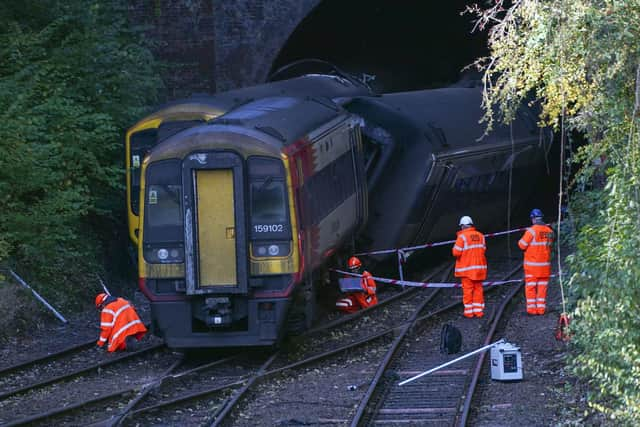Here's what investigators believe caused the Salisbury train crash
and live on Freeview channel 276
Rail Accident Investigation Branch (RAIB) deputy chief inspector Andrew Hall said the “initial evidence” indicates that the driver applied the brakes before the junction where the crash happened, but the train failed to stop.
He went on: ‘The most likely cause of this was wheelslide, almost certainly a result of low adhesion between the wheels and the track.’
Advertisement
Hide AdAdvertisement
Hide AdThe driver had to be rescued from his cab, and suffered what police described as ‘life-changing injuries’.


He was driving a South Western Railway train which struck the side of a Great Western Railway service at a junction outside Fisherton Tunnel in Salisbury at around 6.45pm on Sunday.
Thirteen other people were treated in hospital for minor injuries.
The trains were travelling in the same direction but on separate tracks as they approached the Y-shaped junction carrying a total of 92 passengers.
They collided at the point where the tracks merge.
Advertisement
Hide AdAdvertisement
Hide AdBoth trains derailed and ran alongside each other into the tunnel.
Mr Hall said the GWR train was in front, and the SWR train ‘was required to stop’ at a signal.
‘Unfortunately, it did not stop and struck the side of the Great Western train at an angle such that both trains derailed and ran alongside each other into the tunnel just beyond the junction,’ he added.
Low adhesion between train wheels and rails can be particularly severe in the autumn due to leaves falling from the 13 million trees near Britain’s rail lines.
Advertisement
Hide AdAdvertisement
Hide AdA thin, slippery layer is created when trains pass over leaves, which has a similar effect to black ice on roads.
It makes it harder for trains to accelerate and brake effectively, leading to some operators publishing special autumn timetables to allow extra time for trains to be driven more cautiously.
Martin Frobisher, Network Rail’s safety and engineering director, said: ‘Sunday’s accident was incredibly frightening for everyone involved and our thoughts are with everyone injured or affected in any way.
‘Initial findings suggest that low adhesion played a key part in causing the collision.
Advertisement
Hide AdAdvertisement
Hide Ad‘It’s an issue that affects railways across the world and is something that we, and our train operator colleagues, work hard to combat so that we can run trains safely and reliably throughout autumn, and why incidents such as the one in Salisbury at the weekend are incredibly rare.
‘We will continue to work closely with investigators to understand what happened and what more we can do to help prevent this happening again.’
The RAIB said it has conducted a close examination of the track and signalling in the area, and starting talking to the people involved.
Analysis of CCTV images and data recorded by the train and signalling system is continuing.
Advertisement
Hide AdAdvertisement
Hide AdThe initial findings of the RAIB’s investigation will be published later this week.
Disruption to services through Salisbury is expected to continue until at least the end of the day on November 8.
A message from the Editor, Mark Waldron
You can subscribe here for unlimited access to our online coverage, including Pompey, for 26p a day.
Comment Guidelines
National World encourages reader discussion on our stories. User feedback, insights and back-and-forth exchanges add a rich layer of context to reporting. Please review our Community Guidelines before commenting.
